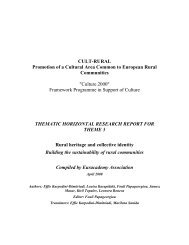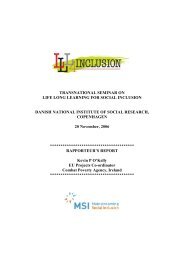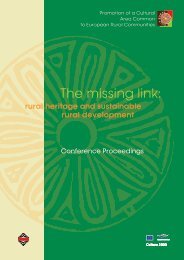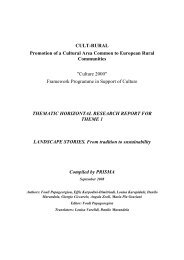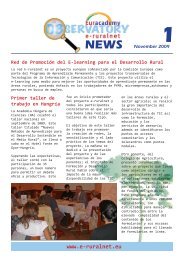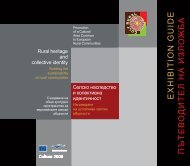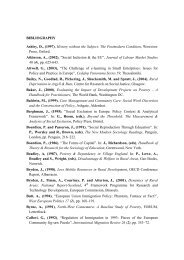Research report by the Jagiellonian University, Poland - cult rural
Research report by the Jagiellonian University, Poland - cult rural
Research report by the Jagiellonian University, Poland - cult rural
- No tags were found...
Create successful ePaper yourself
Turn your PDF publications into a flip-book with our unique Google optimized e-Paper software.
26This specific mortifying <strong>the</strong> flash was a preparation, even a sacrifice, necessary to properlyexperience and perform <strong>the</strong> ritual of transition from winter torpor to spring revival of life.One of <strong>the</strong> oldest Lent customs practiced in Podhale until <strong>the</strong> 1960’s was chodzenie ześmierztecką. Starting on White Sunday called Śmiertna, which was <strong>the</strong> fourth Sunday of Lent,little girls usually from <strong>the</strong> <strong>rural</strong> poor started walking around <strong>the</strong> village with an effigy whichrepresented <strong>the</strong> death attached to a pole. In <strong>the</strong> beginning it was a straw effigy, later a dollmade of pieces cloth, and in <strong>the</strong> interwar period and after <strong>the</strong> second world war a factorymadedoll covered with a white shawl. The girls participating in <strong>the</strong> procession stopped under<strong>the</strong> houses windows and touching <strong>the</strong> glass with śmierzteczka moved it rhythmically up anddown singing a song:Sła śmierztecka z miastaPon Jezus do miastaDziewcenta jom niesomO jojecka prosom.Next <strong>the</strong>y entered a room a got eggs from <strong>the</strong> host and hostess. The whole processionended in a specific execution of śmierztecka which <strong>the</strong> girls drowned <strong>by</strong> throwing it into amountain stream. This action of killing, in which we can find echoes of pagan ritual ofdestroying winter, brings association with a popular in <strong>the</strong> whole <strong>Poland</strong> custom of drowningmarzanna. Thus, we may presume that <strong>the</strong> Podhale śmierztecka was a later transformed <strong>by</strong>Christian tradition sisterly form of marzanna. Similarly, as an effect of transformation of anarchaic monster into a figure of Christian origin, we may interpret a custom of burning Judas,<strong>the</strong> apostle who betrayed Jesus, popular in some villages. The youth made a big doll of strawrepresenting Judas, which was first lit and <strong>the</strong>n carried in a solemn procession to a river anddrowned.Holy Week preceding Resolution Day was begun <strong>by</strong> Palm Sunday which was alsocalled Kwietna (Flowery), in <strong>the</strong> liturgical calendar commemorated Jesus’ solemn arrival atJerusalem. For this occasion <strong>the</strong> inhabitants of Podhale villages prepared palms forconsecrating. They were made of willow twigs covered in catkins which were tied with flax.Consecrated in church <strong>the</strong>y got healing and magic properties. A whip was twisted of flax forshepherds, and <strong>the</strong>y believed that <strong>the</strong> animals penned with it would not lose <strong>the</strong>ir way duringpasturage and nie dostana uroku. Single twigs with catkins were thrust on fields and inorchards as well in <strong>the</strong> farm under <strong>the</strong> roof. During <strong>the</strong> first pasturage <strong>the</strong> cattle was beatenwith <strong>the</strong>m. Farmers used to put catkins toge<strong>the</strong>r with a piece of bread or oats cake calledmoskol under a ridge during <strong>the</strong> first plough. Catkins separated from twigs were thrown to




